Human Resource Development Report: Marriott HR Strategies
VerifiedAdded on 2020/07/22
|18
|5384
|51
Report
AI Summary
This report provides a comprehensive overview of human resource development (HRD) within Marriott. It begins by comparing different learning styles, including Kolb's experiential learning and the Honey and Mumford model, and discusses their importance in enhancing employee skills. The report then explores the significance of the learning curve and learning transfer in the workplace, emphasizing their role in assessing and improving employee performance. It analyzes various training methods, highlighting their advantages and disadvantages. Furthermore, the report details the process of planning a training event, including the preparation of evaluation forms and the analysis of feedback to assess the effectiveness of the training. The report also addresses the role of government in training and development, the impact of competency movements, and contemporary training initiatives. The conclusion summarizes the key findings and emphasizes the importance of HRD in achieving organizational success within Marriott.
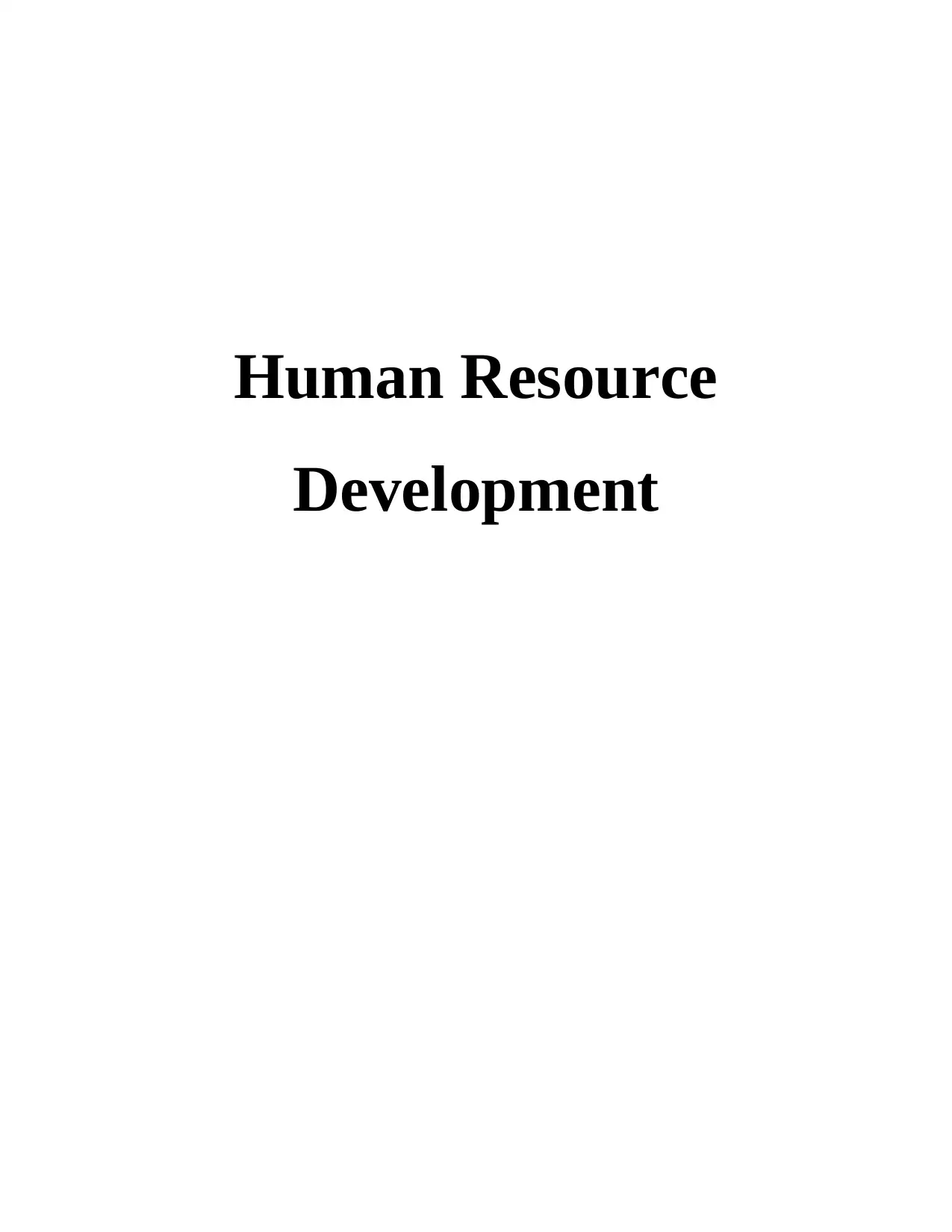
Human Resource
Development
Development
Paraphrase This Document
Need a fresh take? Get an instant paraphrase of this document with our AI Paraphraser
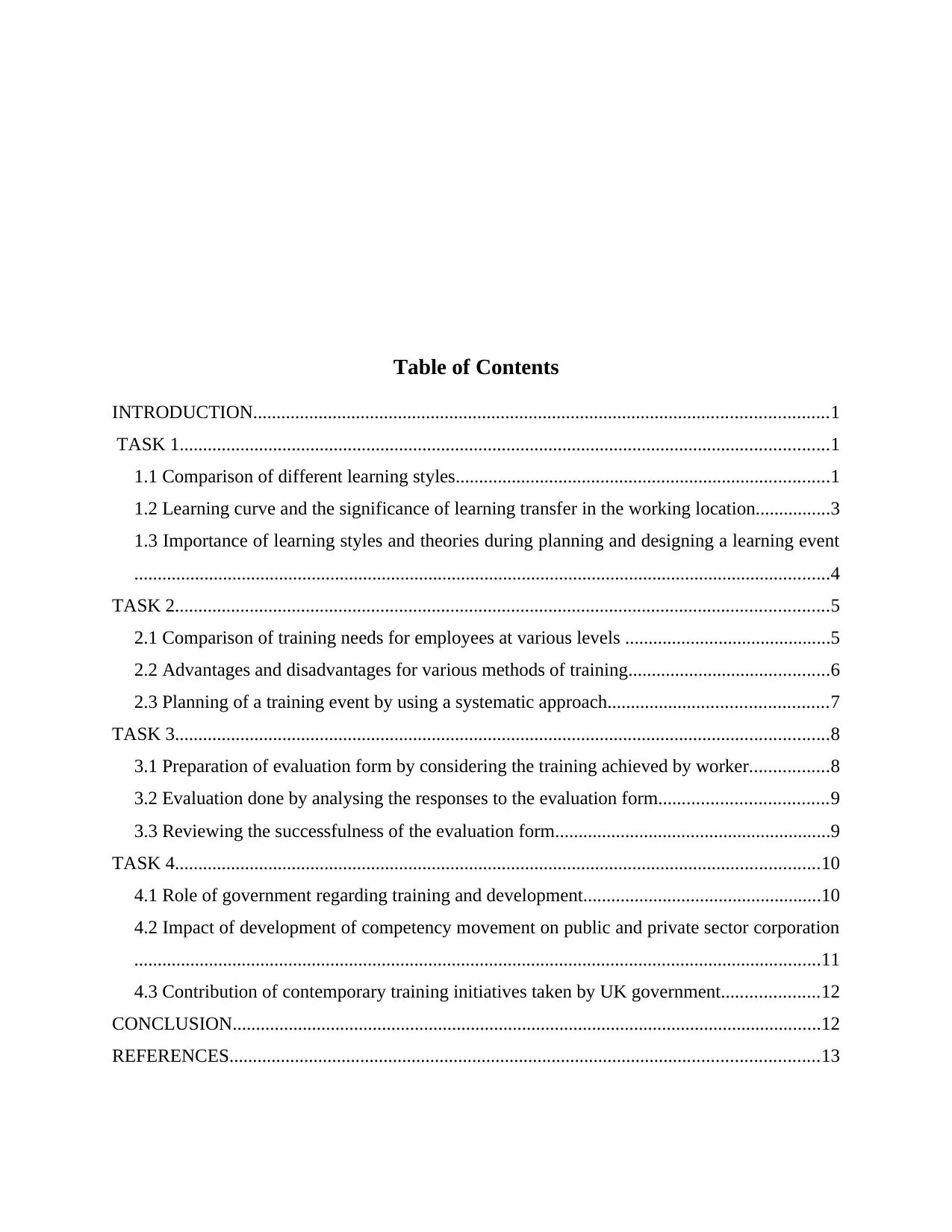
Table of Contents
INTRODUCTION...........................................................................................................................1
TASK 1...........................................................................................................................................1
1.1 Comparison of different learning styles................................................................................1
1.2 Learning curve and the significance of learning transfer in the working location................3
1.3 Importance of learning styles and theories during planning and designing a learning event
.....................................................................................................................................................4
TASK 2............................................................................................................................................5
2.1 Comparison of training needs for employees at various levels ............................................5
2.2 Advantages and disadvantages for various methods of training...........................................6
2.3 Planning of a training event by using a systematic approach...............................................7
TASK 3............................................................................................................................................8
3.1 Preparation of evaluation form by considering the training achieved by worker.................8
3.2 Evaluation done by analysing the responses to the evaluation form....................................9
3.3 Reviewing the successfulness of the evaluation form...........................................................9
TASK 4..........................................................................................................................................10
4.1 Role of government regarding training and development...................................................10
4.2 Impact of development of competency movement on public and private sector corporation
...................................................................................................................................................11
4.3 Contribution of contemporary training initiatives taken by UK government.....................12
CONCLUSION..............................................................................................................................12
REFERENCES..............................................................................................................................13
INTRODUCTION...........................................................................................................................1
TASK 1...........................................................................................................................................1
1.1 Comparison of different learning styles................................................................................1
1.2 Learning curve and the significance of learning transfer in the working location................3
1.3 Importance of learning styles and theories during planning and designing a learning event
.....................................................................................................................................................4
TASK 2............................................................................................................................................5
2.1 Comparison of training needs for employees at various levels ............................................5
2.2 Advantages and disadvantages for various methods of training...........................................6
2.3 Planning of a training event by using a systematic approach...............................................7
TASK 3............................................................................................................................................8
3.1 Preparation of evaluation form by considering the training achieved by worker.................8
3.2 Evaluation done by analysing the responses to the evaluation form....................................9
3.3 Reviewing the successfulness of the evaluation form...........................................................9
TASK 4..........................................................................................................................................10
4.1 Role of government regarding training and development...................................................10
4.2 Impact of development of competency movement on public and private sector corporation
...................................................................................................................................................11
4.3 Contribution of contemporary training initiatives taken by UK government.....................12
CONCLUSION..............................................................................................................................12
REFERENCES..............................................................................................................................13

⊘ This is a preview!⊘
Do you want full access?
Subscribe today to unlock all pages.

Trusted by 1+ million students worldwide
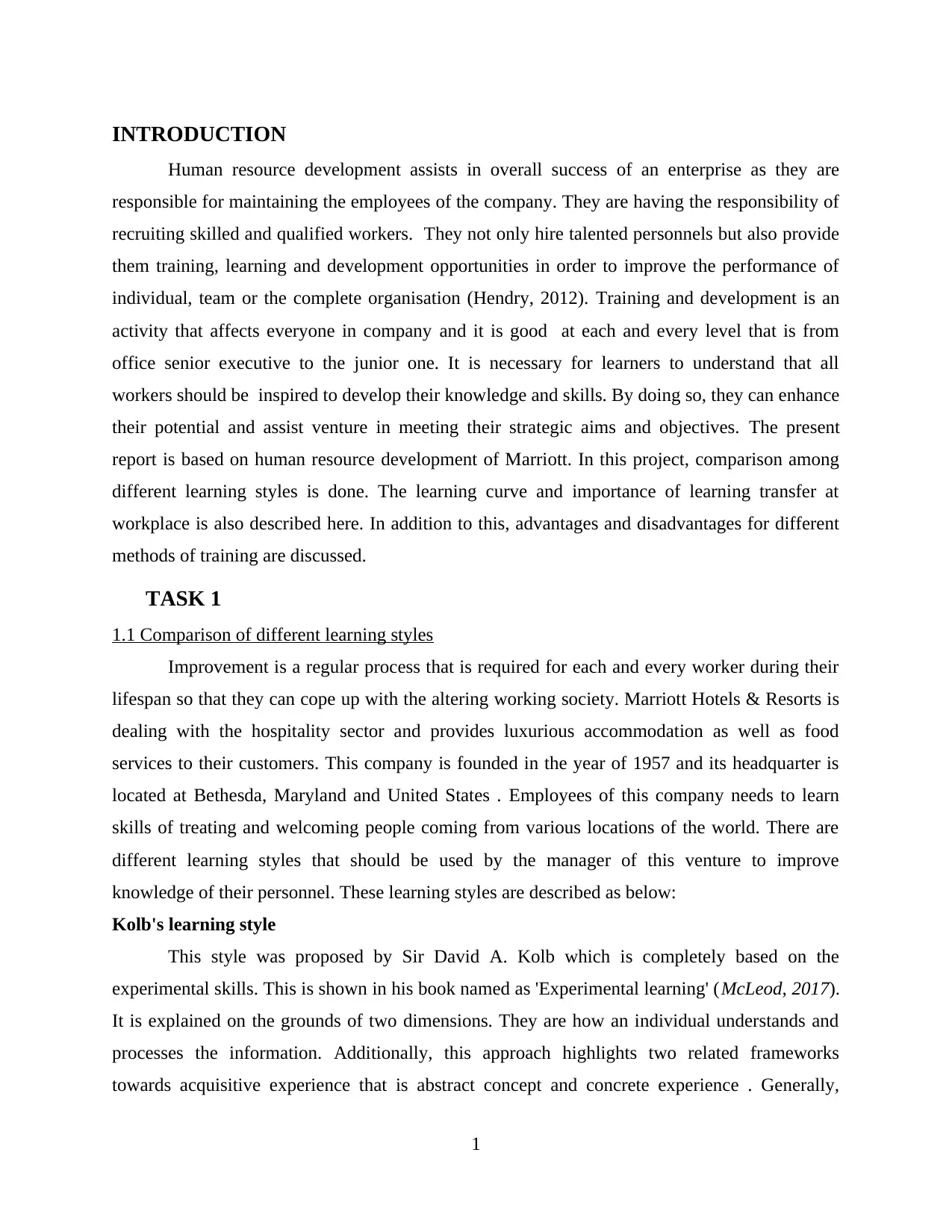
INTRODUCTION
Human resource development assists in overall success of an enterprise as they are
responsible for maintaining the employees of the company. They are having the responsibility of
recruiting skilled and qualified workers. They not only hire talented personnels but also provide
them training, learning and development opportunities in order to improve the performance of
individual, team or the complete organisation (Hendry, 2012). Training and development is an
activity that affects everyone in company and it is good at each and every level that is from
office senior executive to the junior one. It is necessary for learners to understand that all
workers should be inspired to develop their knowledge and skills. By doing so, they can enhance
their potential and assist venture in meeting their strategic aims and objectives. The present
report is based on human resource development of Marriott. In this project, comparison among
different learning styles is done. The learning curve and importance of learning transfer at
workplace is also described here. In addition to this, advantages and disadvantages for different
methods of training are discussed.
TASK 1
1.1 Comparison of different learning styles
Improvement is a regular process that is required for each and every worker during their
lifespan so that they can cope up with the altering working society. Marriott Hotels & Resorts is
dealing with the hospitality sector and provides luxurious accommodation as well as food
services to their customers. This company is founded in the year of 1957 and its headquarter is
located at Bethesda, Maryland and United States . Employees of this company needs to learn
skills of treating and welcoming people coming from various locations of the world. There are
different learning styles that should be used by the manager of this venture to improve
knowledge of their personnel. These learning styles are described as below:
Kolb's learning style
This style was proposed by Sir David A. Kolb which is completely based on the
experimental skills. This is shown in his book named as 'Experimental learning' (McLeod, 2017).
It is explained on the grounds of two dimensions. They are how an individual understands and
processes the information. Additionally, this approach highlights two related frameworks
towards acquisitive experience that is abstract concept and concrete experience . Generally,
1
Human resource development assists in overall success of an enterprise as they are
responsible for maintaining the employees of the company. They are having the responsibility of
recruiting skilled and qualified workers. They not only hire talented personnels but also provide
them training, learning and development opportunities in order to improve the performance of
individual, team or the complete organisation (Hendry, 2012). Training and development is an
activity that affects everyone in company and it is good at each and every level that is from
office senior executive to the junior one. It is necessary for learners to understand that all
workers should be inspired to develop their knowledge and skills. By doing so, they can enhance
their potential and assist venture in meeting their strategic aims and objectives. The present
report is based on human resource development of Marriott. In this project, comparison among
different learning styles is done. The learning curve and importance of learning transfer at
workplace is also described here. In addition to this, advantages and disadvantages for different
methods of training are discussed.
TASK 1
1.1 Comparison of different learning styles
Improvement is a regular process that is required for each and every worker during their
lifespan so that they can cope up with the altering working society. Marriott Hotels & Resorts is
dealing with the hospitality sector and provides luxurious accommodation as well as food
services to their customers. This company is founded in the year of 1957 and its headquarter is
located at Bethesda, Maryland and United States . Employees of this company needs to learn
skills of treating and welcoming people coming from various locations of the world. There are
different learning styles that should be used by the manager of this venture to improve
knowledge of their personnel. These learning styles are described as below:
Kolb's learning style
This style was proposed by Sir David A. Kolb which is completely based on the
experimental skills. This is shown in his book named as 'Experimental learning' (McLeod, 2017).
It is explained on the grounds of two dimensions. They are how an individual understands and
processes the information. Additionally, this approach highlights two related frameworks
towards acquisitive experience that is abstract concept and concrete experience . Generally,
1
Paraphrase This Document
Need a fresh take? Get an instant paraphrase of this document with our AI Paraphraser
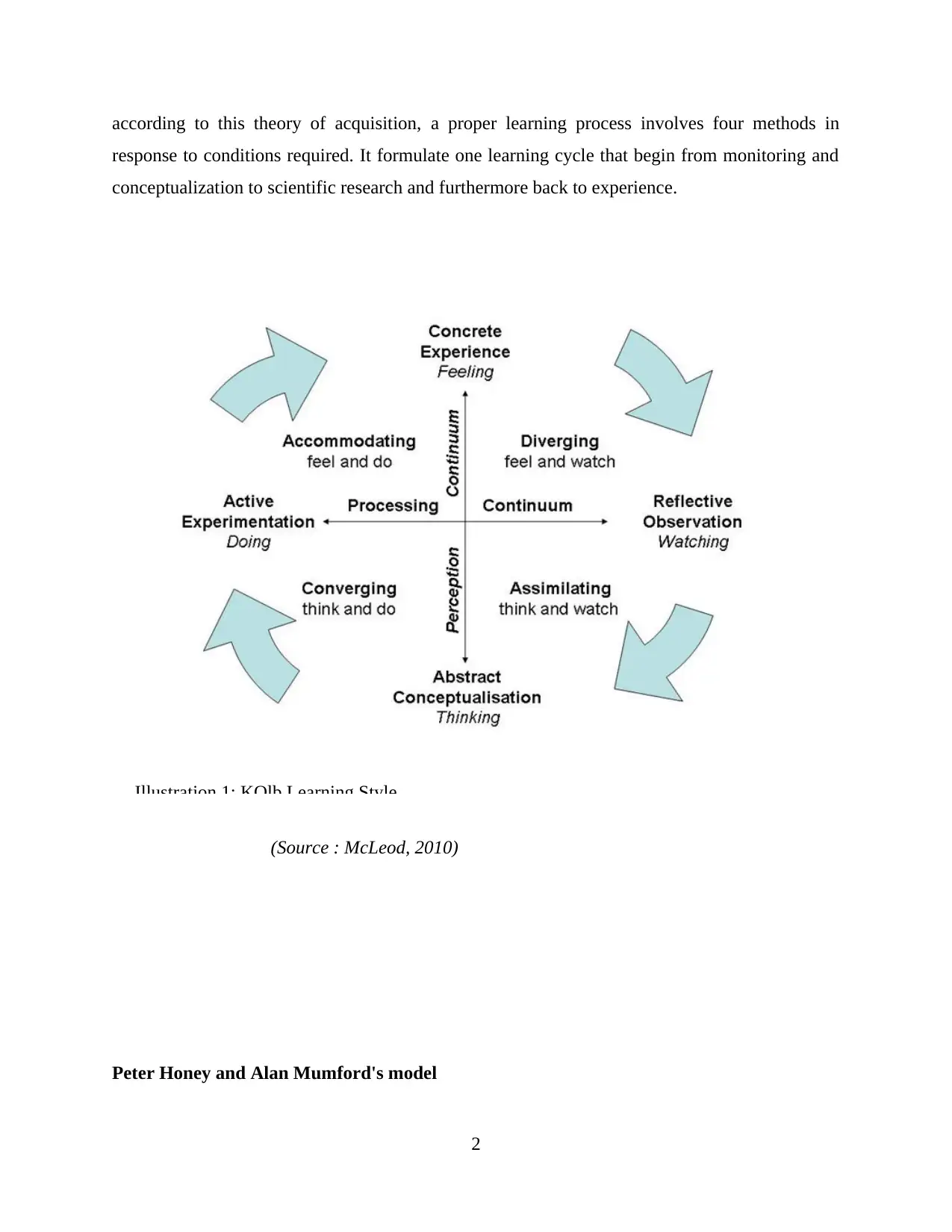
according to this theory of acquisition, a proper learning process involves four methods in
response to conditions required. It formulate one learning cycle that begin from monitoring and
conceptualization to scientific research and furthermore back to experience.
(Source : McLeod, 2010)
Peter Honey and Alan Mumford's model
2
Illustration 1: KOlb Learning Style
response to conditions required. It formulate one learning cycle that begin from monitoring and
conceptualization to scientific research and furthermore back to experience.
(Source : McLeod, 2010)
Peter Honey and Alan Mumford's model
2
Illustration 1: KOlb Learning Style
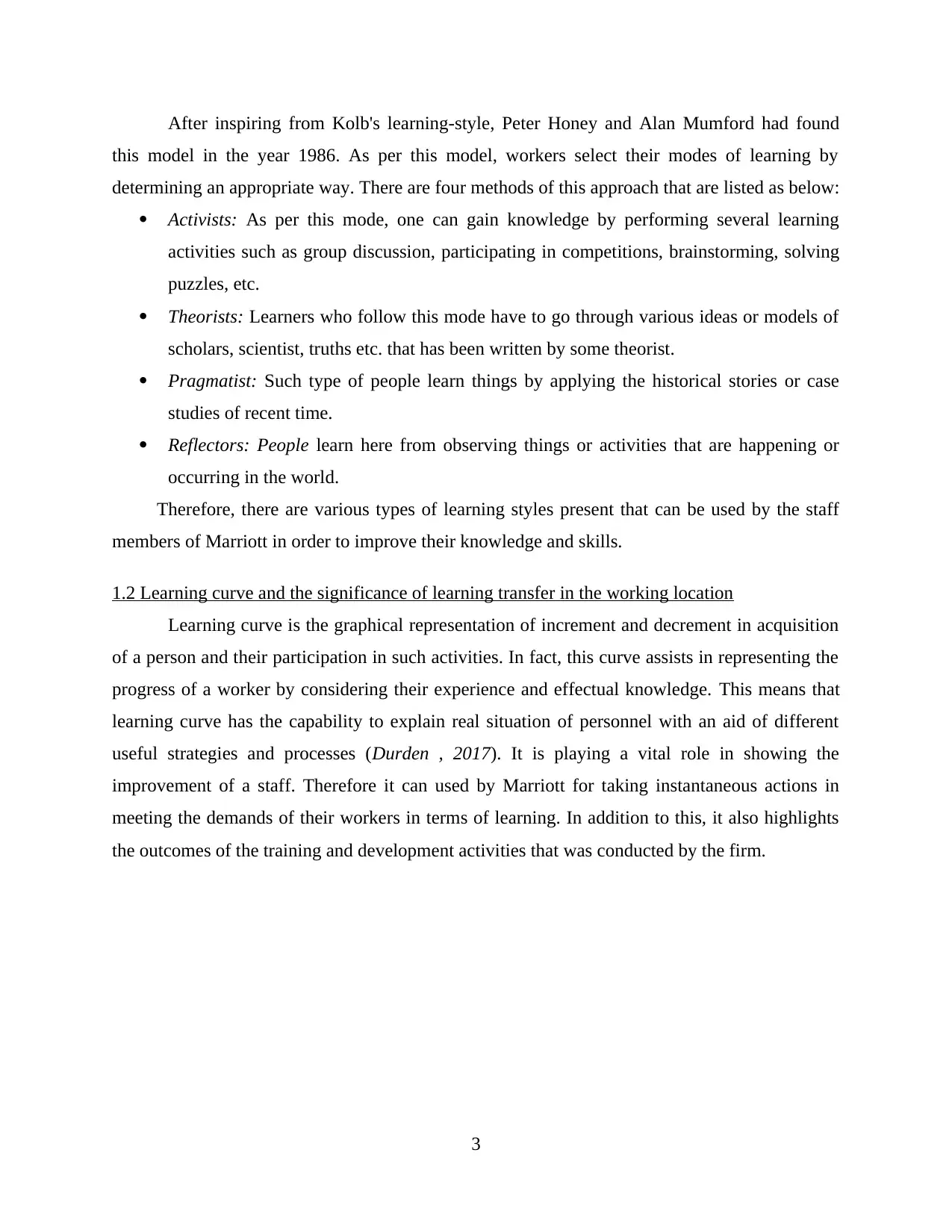
After inspiring from Kolb's learning-style, Peter Honey and Alan Mumford had found
this model in the year 1986. As per this model, workers select their modes of learning by
determining an appropriate way. There are four methods of this approach that are listed as below:
Activists: As per this mode, one can gain knowledge by performing several learning
activities such as group discussion, participating in competitions, brainstorming, solving
puzzles, etc.
Theorists: Learners who follow this mode have to go through various ideas or models of
scholars, scientist, truths etc. that has been written by some theorist.
Pragmatist: Such type of people learn things by applying the historical stories or case
studies of recent time.
Reflectors: People learn here from observing things or activities that are happening or
occurring in the world.
Therefore, there are various types of learning styles present that can be used by the staff
members of Marriott in order to improve their knowledge and skills.
1.2 Learning curve and the significance of learning transfer in the working location
Learning curve is the graphical representation of increment and decrement in acquisition
of a person and their participation in such activities. In fact, this curve assists in representing the
progress of a worker by considering their experience and effectual knowledge. This means that
learning curve has the capability to explain real situation of personnel with an aid of different
useful strategies and processes (Durden , 2017). It is playing a vital role in showing the
improvement of a staff. Therefore it can used by Marriott for taking instantaneous actions in
meeting the demands of their workers in terms of learning. In addition to this, it also highlights
the outcomes of the training and development activities that was conducted by the firm.
3
this model in the year 1986. As per this model, workers select their modes of learning by
determining an appropriate way. There are four methods of this approach that are listed as below:
Activists: As per this mode, one can gain knowledge by performing several learning
activities such as group discussion, participating in competitions, brainstorming, solving
puzzles, etc.
Theorists: Learners who follow this mode have to go through various ideas or models of
scholars, scientist, truths etc. that has been written by some theorist.
Pragmatist: Such type of people learn things by applying the historical stories or case
studies of recent time.
Reflectors: People learn here from observing things or activities that are happening or
occurring in the world.
Therefore, there are various types of learning styles present that can be used by the staff
members of Marriott in order to improve their knowledge and skills.
1.2 Learning curve and the significance of learning transfer in the working location
Learning curve is the graphical representation of increment and decrement in acquisition
of a person and their participation in such activities. In fact, this curve assists in representing the
progress of a worker by considering their experience and effectual knowledge. This means that
learning curve has the capability to explain real situation of personnel with an aid of different
useful strategies and processes (Durden , 2017). It is playing a vital role in showing the
improvement of a staff. Therefore it can used by Marriott for taking instantaneous actions in
meeting the demands of their workers in terms of learning. In addition to this, it also highlights
the outcomes of the training and development activities that was conducted by the firm.
3
⊘ This is a preview!⊘
Do you want full access?
Subscribe today to unlock all pages.

Trusted by 1+ million students worldwide
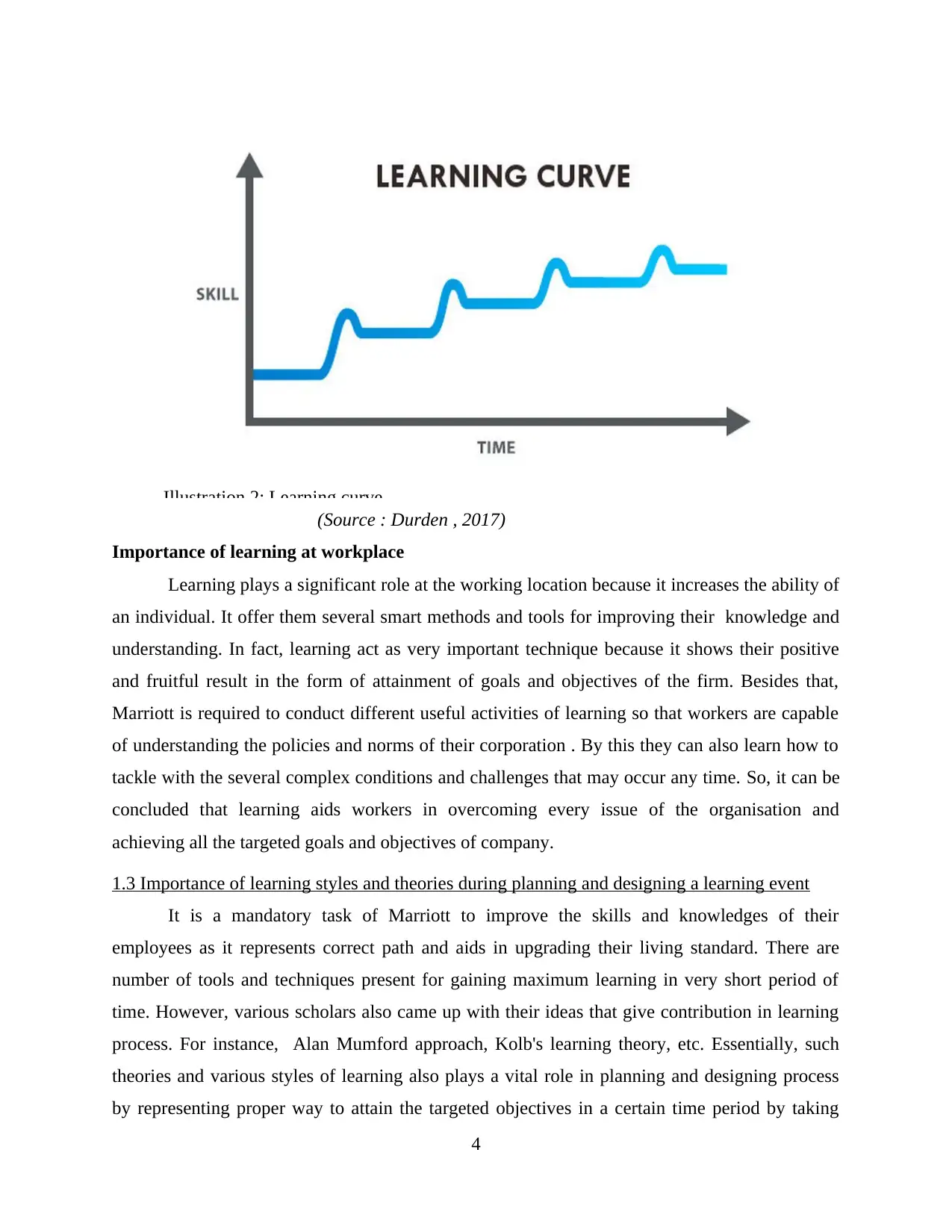
(Source : Durden , 2017)
Importance of learning at workplace
Learning plays a significant role at the working location because it increases the ability of
an individual. It offer them several smart methods and tools for improving their knowledge and
understanding. In fact, learning act as very important technique because it shows their positive
and fruitful result in the form of attainment of goals and objectives of the firm. Besides that,
Marriott is required to conduct different useful activities of learning so that workers are capable
of understanding the policies and norms of their corporation . By this they can also learn how to
tackle with the several complex conditions and challenges that may occur any time. So, it can be
concluded that learning aids workers in overcoming every issue of the organisation and
achieving all the targeted goals and objectives of company.
1.3 Importance of learning styles and theories during planning and designing a learning event
It is a mandatory task of Marriott to improve the skills and knowledges of their
employees as it represents correct path and aids in upgrading their living standard. There are
number of tools and techniques present for gaining maximum learning in very short period of
time. However, various scholars also came up with their ideas that give contribution in learning
process. For instance, Alan Mumford approach, Kolb's learning theory, etc. Essentially, such
theories and various styles of learning also plays a vital role in planning and designing process
by representing proper way to attain the targeted objectives in a certain time period by taking
4
Illustration 2: Learning curve
Importance of learning at workplace
Learning plays a significant role at the working location because it increases the ability of
an individual. It offer them several smart methods and tools for improving their knowledge and
understanding. In fact, learning act as very important technique because it shows their positive
and fruitful result in the form of attainment of goals and objectives of the firm. Besides that,
Marriott is required to conduct different useful activities of learning so that workers are capable
of understanding the policies and norms of their corporation . By this they can also learn how to
tackle with the several complex conditions and challenges that may occur any time. So, it can be
concluded that learning aids workers in overcoming every issue of the organisation and
achieving all the targeted goals and objectives of company.
1.3 Importance of learning styles and theories during planning and designing a learning event
It is a mandatory task of Marriott to improve the skills and knowledges of their
employees as it represents correct path and aids in upgrading their living standard. There are
number of tools and techniques present for gaining maximum learning in very short period of
time. However, various scholars also came up with their ideas that give contribution in learning
process. For instance, Alan Mumford approach, Kolb's learning theory, etc. Essentially, such
theories and various styles of learning also plays a vital role in planning and designing process
by representing proper way to attain the targeted objectives in a certain time period by taking
4
Illustration 2: Learning curve
Paraphrase This Document
Need a fresh take? Get an instant paraphrase of this document with our AI Paraphraser
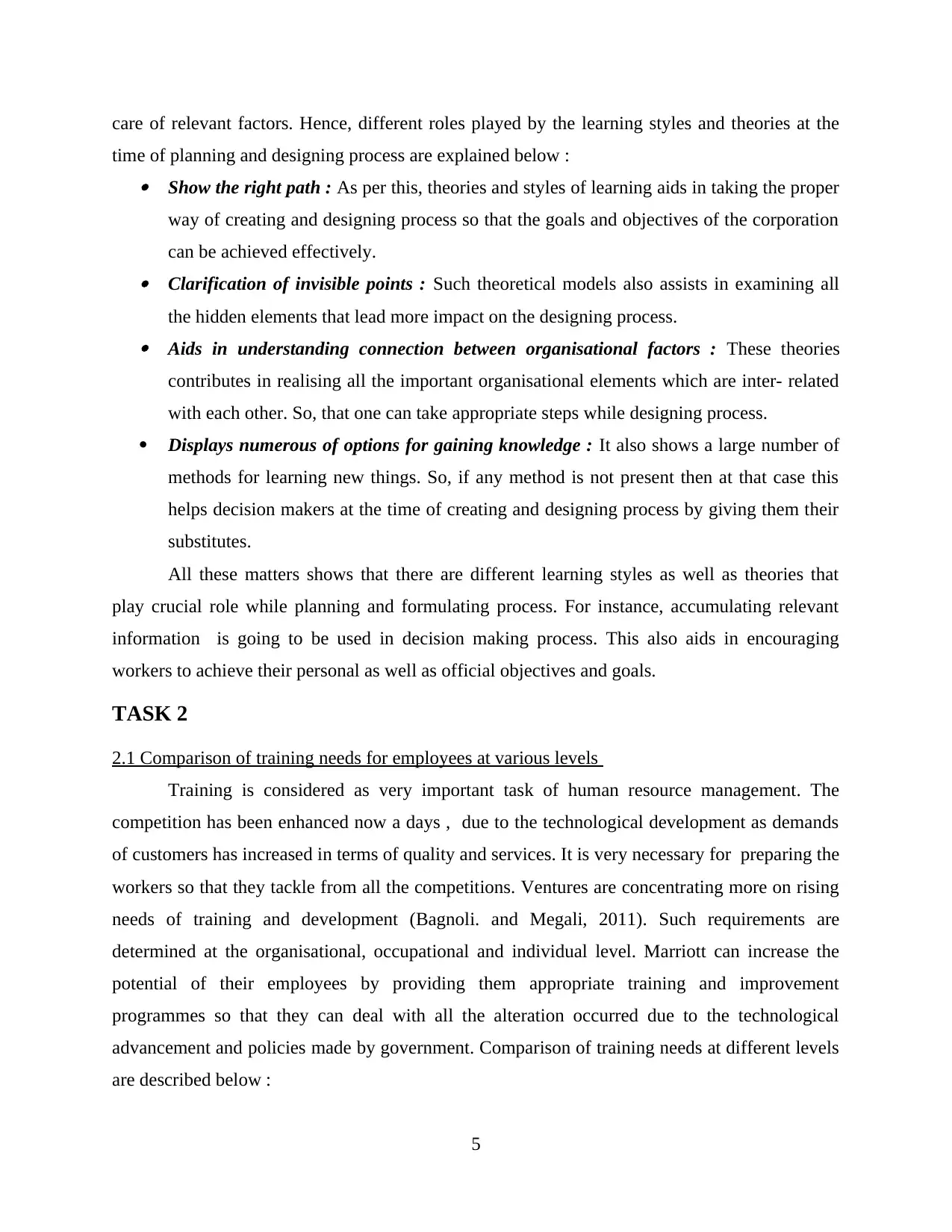
care of relevant factors. Hence, different roles played by the learning styles and theories at the
time of planning and designing process are explained below : Show the right path : As per this, theories and styles of learning aids in taking the proper
way of creating and designing process so that the goals and objectives of the corporation
can be achieved effectively. Clarification of invisible points : Such theoretical models also assists in examining all
the hidden elements that lead more impact on the designing process. Aids in understanding connection between organisational factors : These theories
contributes in realising all the important organisational elements which are inter- related
with each other. So, that one can take appropriate steps while designing process.
Displays numerous of options for gaining knowledge : It also shows a large number of
methods for learning new things. So, if any method is not present then at that case this
helps decision makers at the time of creating and designing process by giving them their
substitutes.
All these matters shows that there are different learning styles as well as theories that
play crucial role while planning and formulating process. For instance, accumulating relevant
information is going to be used in decision making process. This also aids in encouraging
workers to achieve their personal as well as official objectives and goals.
TASK 2
2.1 Comparison of training needs for employees at various levels
Training is considered as very important task of human resource management. The
competition has been enhanced now a days , due to the technological development as demands
of customers has increased in terms of quality and services. It is very necessary for preparing the
workers so that they tackle from all the competitions. Ventures are concentrating more on rising
needs of training and development (Bagnoli. and Megali, 2011). Such requirements are
determined at the organisational, occupational and individual level. Marriott can increase the
potential of their employees by providing them appropriate training and improvement
programmes so that they can deal with all the alteration occurred due to the technological
advancement and policies made by government. Comparison of training needs at different levels
are described below :
5
time of planning and designing process are explained below : Show the right path : As per this, theories and styles of learning aids in taking the proper
way of creating and designing process so that the goals and objectives of the corporation
can be achieved effectively. Clarification of invisible points : Such theoretical models also assists in examining all
the hidden elements that lead more impact on the designing process. Aids in understanding connection between organisational factors : These theories
contributes in realising all the important organisational elements which are inter- related
with each other. So, that one can take appropriate steps while designing process.
Displays numerous of options for gaining knowledge : It also shows a large number of
methods for learning new things. So, if any method is not present then at that case this
helps decision makers at the time of creating and designing process by giving them their
substitutes.
All these matters shows that there are different learning styles as well as theories that
play crucial role while planning and formulating process. For instance, accumulating relevant
information is going to be used in decision making process. This also aids in encouraging
workers to achieve their personal as well as official objectives and goals.
TASK 2
2.1 Comparison of training needs for employees at various levels
Training is considered as very important task of human resource management. The
competition has been enhanced now a days , due to the technological development as demands
of customers has increased in terms of quality and services. It is very necessary for preparing the
workers so that they tackle from all the competitions. Ventures are concentrating more on rising
needs of training and development (Bagnoli. and Megali, 2011). Such requirements are
determined at the organisational, occupational and individual level. Marriott can increase the
potential of their employees by providing them appropriate training and improvement
programmes so that they can deal with all the alteration occurred due to the technological
advancement and policies made by government. Comparison of training needs at different levels
are described below :
5
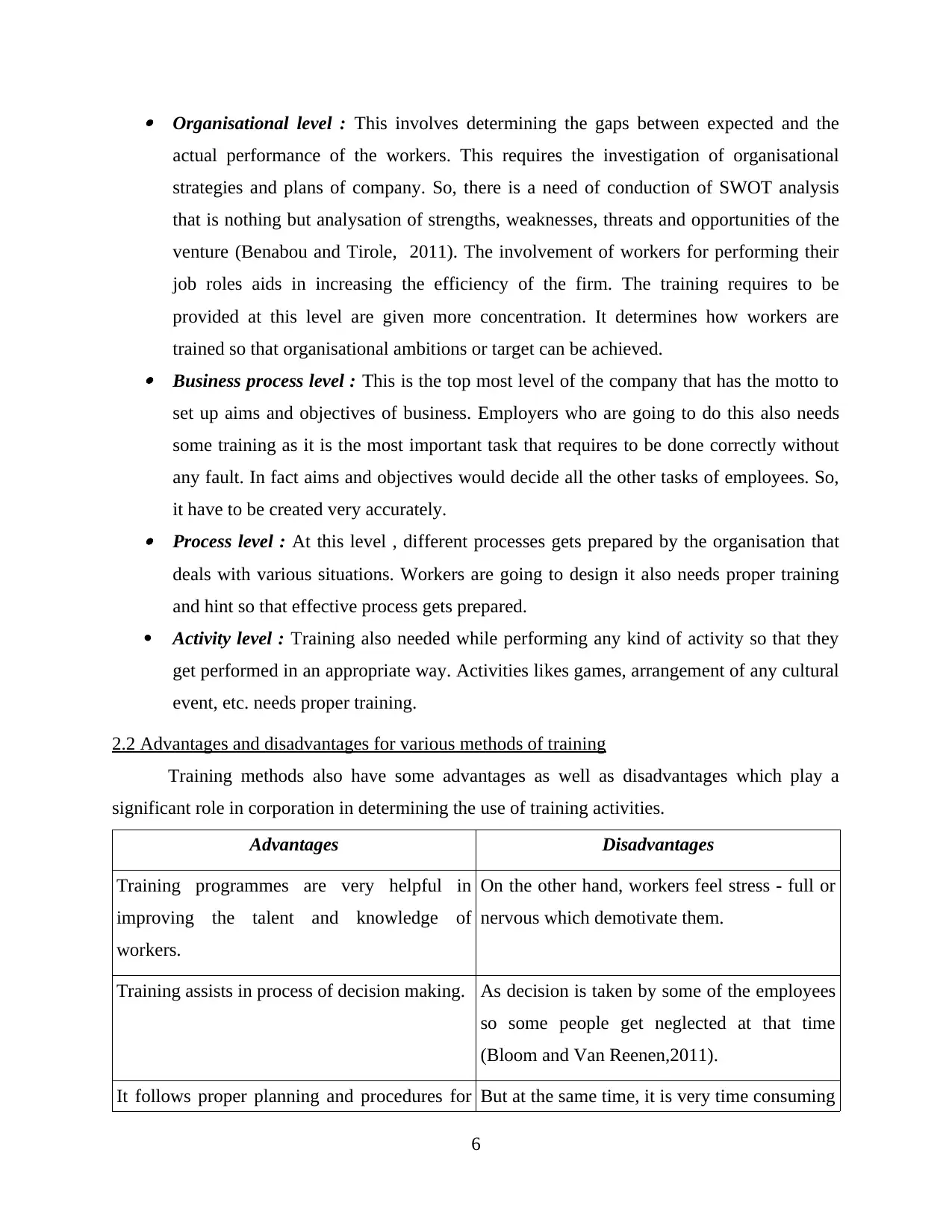
Organisational level : This involves determining the gaps between expected and the
actual performance of the workers. This requires the investigation of organisational
strategies and plans of company. So, there is a need of conduction of SWOT analysis
that is nothing but analysation of strengths, weaknesses, threats and opportunities of the
venture (Benabou and Tirole, 2011). The involvement of workers for performing their
job roles aids in increasing the efficiency of the firm. The training requires to be
provided at this level are given more concentration. It determines how workers are
trained so that organisational ambitions or target can be achieved. Business process level : This is the top most level of the company that has the motto to
set up aims and objectives of business. Employers who are going to do this also needs
some training as it is the most important task that requires to be done correctly without
any fault. In fact aims and objectives would decide all the other tasks of employees. So,
it have to be created very accurately. Process level : At this level , different processes gets prepared by the organisation that
deals with various situations. Workers are going to design it also needs proper training
and hint so that effective process gets prepared.
Activity level : Training also needed while performing any kind of activity so that they
get performed in an appropriate way. Activities likes games, arrangement of any cultural
event, etc. needs proper training.
2.2 Advantages and disadvantages for various methods of training
Training methods also have some advantages as well as disadvantages which play a
significant role in corporation in determining the use of training activities.
Advantages Disadvantages
Training programmes are very helpful in
improving the talent and knowledge of
workers.
On the other hand, workers feel stress - full or
nervous which demotivate them.
Training assists in process of decision making. As decision is taken by some of the employees
so some people get neglected at that time
(Bloom and Van Reenen,2011).
It follows proper planning and procedures for But at the same time, it is very time consuming
6
actual performance of the workers. This requires the investigation of organisational
strategies and plans of company. So, there is a need of conduction of SWOT analysis
that is nothing but analysation of strengths, weaknesses, threats and opportunities of the
venture (Benabou and Tirole, 2011). The involvement of workers for performing their
job roles aids in increasing the efficiency of the firm. The training requires to be
provided at this level are given more concentration. It determines how workers are
trained so that organisational ambitions or target can be achieved. Business process level : This is the top most level of the company that has the motto to
set up aims and objectives of business. Employers who are going to do this also needs
some training as it is the most important task that requires to be done correctly without
any fault. In fact aims and objectives would decide all the other tasks of employees. So,
it have to be created very accurately. Process level : At this level , different processes gets prepared by the organisation that
deals with various situations. Workers are going to design it also needs proper training
and hint so that effective process gets prepared.
Activity level : Training also needed while performing any kind of activity so that they
get performed in an appropriate way. Activities likes games, arrangement of any cultural
event, etc. needs proper training.
2.2 Advantages and disadvantages for various methods of training
Training methods also have some advantages as well as disadvantages which play a
significant role in corporation in determining the use of training activities.
Advantages Disadvantages
Training programmes are very helpful in
improving the talent and knowledge of
workers.
On the other hand, workers feel stress - full or
nervous which demotivate them.
Training assists in process of decision making. As decision is taken by some of the employees
so some people get neglected at that time
(Bloom and Van Reenen,2011).
It follows proper planning and procedures for But at the same time, it is very time consuming
6
⊘ This is a preview!⊘
Do you want full access?
Subscribe today to unlock all pages.

Trusted by 1+ million students worldwide
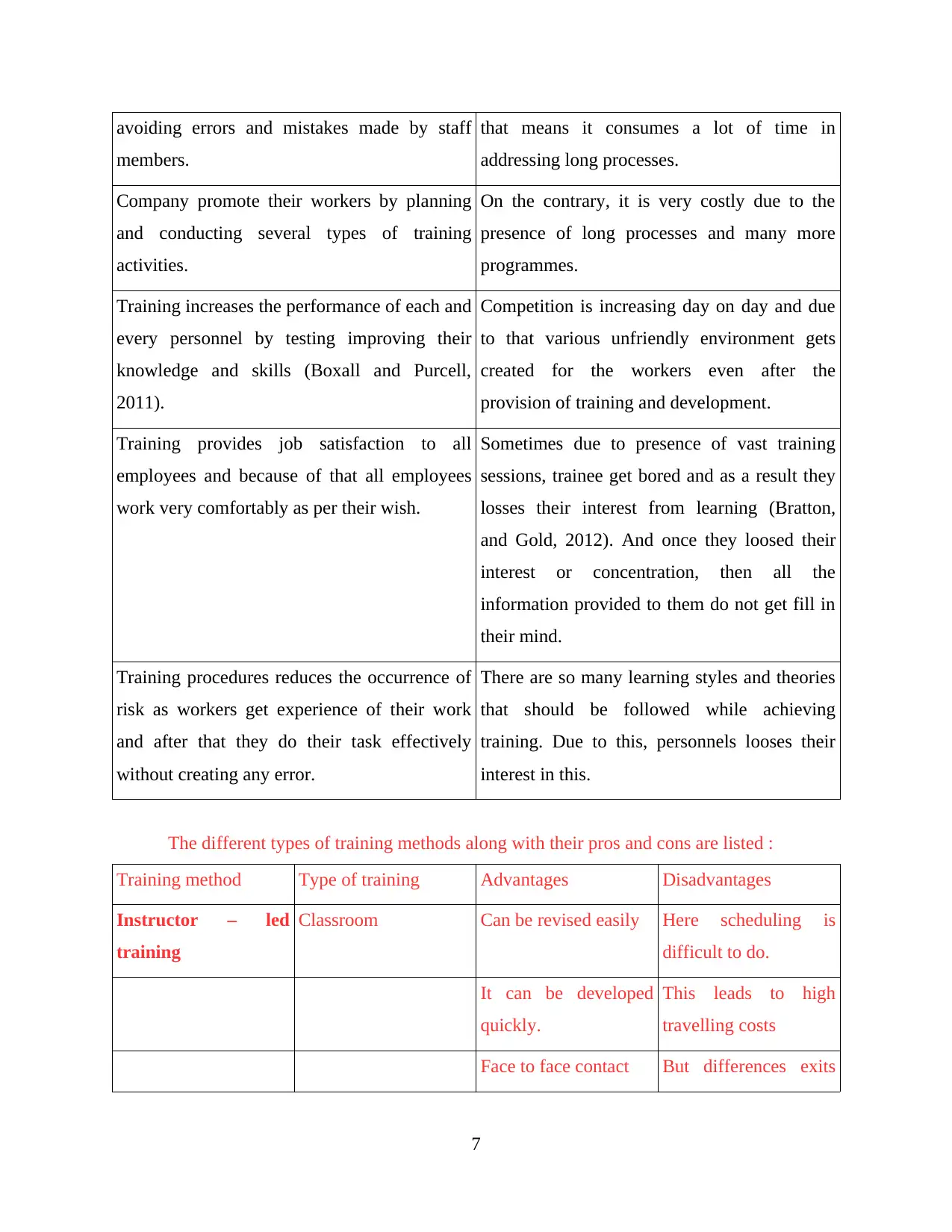
avoiding errors and mistakes made by staff
members.
that means it consumes a lot of time in
addressing long processes.
Company promote their workers by planning
and conducting several types of training
activities.
On the contrary, it is very costly due to the
presence of long processes and many more
programmes.
Training increases the performance of each and
every personnel by testing improving their
knowledge and skills (Boxall and Purcell,
2011).
Competition is increasing day on day and due
to that various unfriendly environment gets
created for the workers even after the
provision of training and development.
Training provides job satisfaction to all
employees and because of that all employees
work very comfortably as per their wish.
Sometimes due to presence of vast training
sessions, trainee get bored and as a result they
losses their interest from learning (Bratton,
and Gold, 2012). And once they loosed their
interest or concentration, then all the
information provided to them do not get fill in
their mind.
Training procedures reduces the occurrence of
risk as workers get experience of their work
and after that they do their task effectively
without creating any error.
There are so many learning styles and theories
that should be followed while achieving
training. Due to this, personnels looses their
interest in this.
The different types of training methods along with their pros and cons are listed :
Training method Type of training Advantages Disadvantages
Instructor – led
training
Classroom Can be revised easily Here scheduling is
difficult to do.
It can be developed
quickly.
This leads to high
travelling costs
Face to face contact But differences exits
7
members.
that means it consumes a lot of time in
addressing long processes.
Company promote their workers by planning
and conducting several types of training
activities.
On the contrary, it is very costly due to the
presence of long processes and many more
programmes.
Training increases the performance of each and
every personnel by testing improving their
knowledge and skills (Boxall and Purcell,
2011).
Competition is increasing day on day and due
to that various unfriendly environment gets
created for the workers even after the
provision of training and development.
Training provides job satisfaction to all
employees and because of that all employees
work very comfortably as per their wish.
Sometimes due to presence of vast training
sessions, trainee get bored and as a result they
losses their interest from learning (Bratton,
and Gold, 2012). And once they loosed their
interest or concentration, then all the
information provided to them do not get fill in
their mind.
Training procedures reduces the occurrence of
risk as workers get experience of their work
and after that they do their task effectively
without creating any error.
There are so many learning styles and theories
that should be followed while achieving
training. Due to this, personnels looses their
interest in this.
The different types of training methods along with their pros and cons are listed :
Training method Type of training Advantages Disadvantages
Instructor – led
training
Classroom Can be revised easily Here scheduling is
difficult to do.
It can be developed
quickly.
This leads to high
travelling costs
Face to face contact But differences exits
7
Paraphrase This Document
Need a fresh take? Get an instant paraphrase of this document with our AI Paraphraser
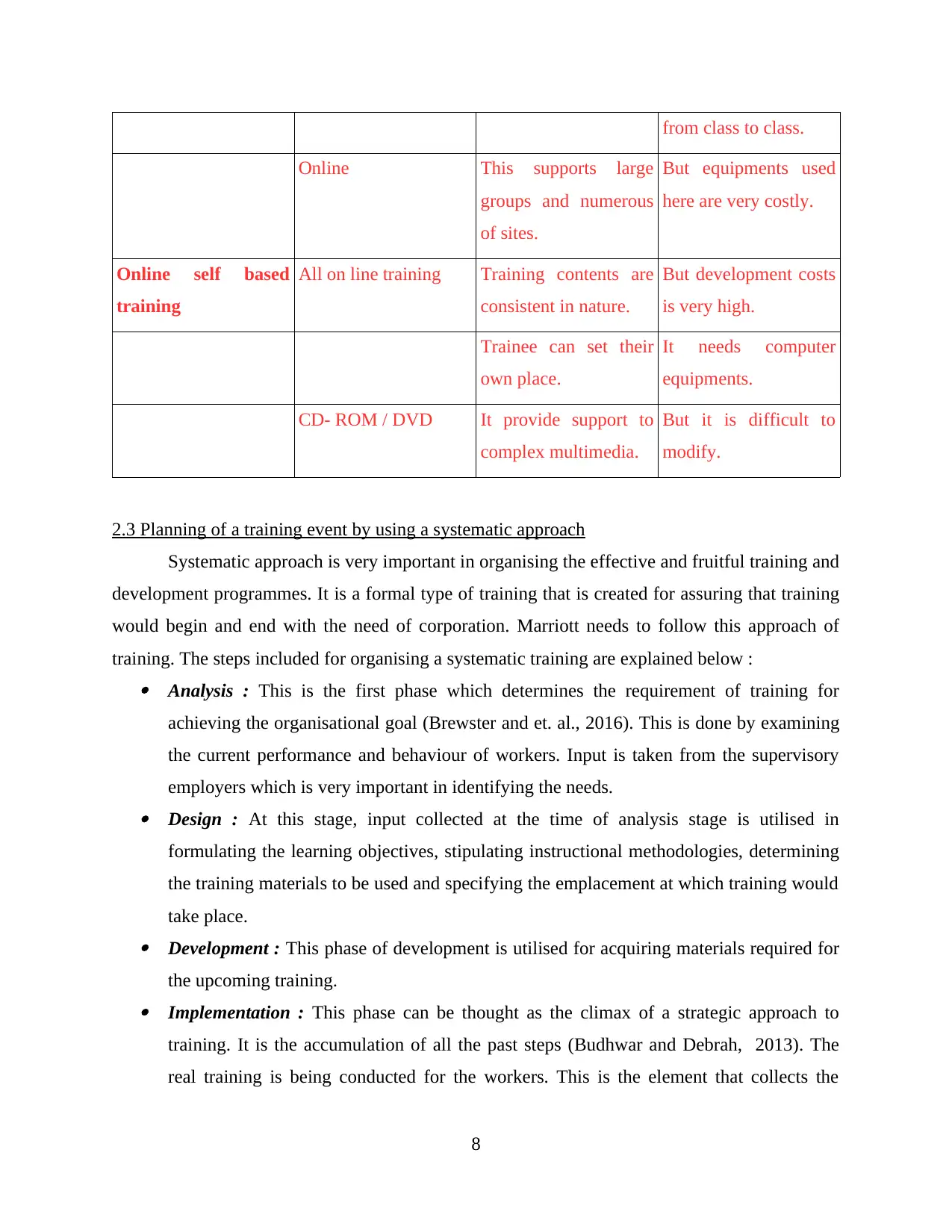
from class to class.
Online This supports large
groups and numerous
of sites.
But equipments used
here are very costly.
Online self based
training
All on line training Training contents are
consistent in nature.
But development costs
is very high.
Trainee can set their
own place.
It needs computer
equipments.
CD- ROM / DVD It provide support to
complex multimedia.
But it is difficult to
modify.
2.3 Planning of a training event by using a systematic approach
Systematic approach is very important in organising the effective and fruitful training and
development programmes. It is a formal type of training that is created for assuring that training
would begin and end with the need of corporation. Marriott needs to follow this approach of
training. The steps included for organising a systematic training are explained below : Analysis : This is the first phase which determines the requirement of training for
achieving the organisational goal (Brewster and et. al., 2016). This is done by examining
the current performance and behaviour of workers. Input is taken from the supervisory
employers which is very important in identifying the needs. Design : At this stage, input collected at the time of analysis stage is utilised in
formulating the learning objectives, stipulating instructional methodologies, determining
the training materials to be used and specifying the emplacement at which training would
take place. Development : This phase of development is utilised for acquiring materials required for
the upcoming training. Implementation : This phase can be thought as the climax of a strategic approach to
training. It is the accumulation of all the past steps (Budhwar and Debrah, 2013). The
real training is being conducted for the workers. This is the element that collects the
8
Online This supports large
groups and numerous
of sites.
But equipments used
here are very costly.
Online self based
training
All on line training Training contents are
consistent in nature.
But development costs
is very high.
Trainee can set their
own place.
It needs computer
equipments.
CD- ROM / DVD It provide support to
complex multimedia.
But it is difficult to
modify.
2.3 Planning of a training event by using a systematic approach
Systematic approach is very important in organising the effective and fruitful training and
development programmes. It is a formal type of training that is created for assuring that training
would begin and end with the need of corporation. Marriott needs to follow this approach of
training. The steps included for organising a systematic training are explained below : Analysis : This is the first phase which determines the requirement of training for
achieving the organisational goal (Brewster and et. al., 2016). This is done by examining
the current performance and behaviour of workers. Input is taken from the supervisory
employers which is very important in identifying the needs. Design : At this stage, input collected at the time of analysis stage is utilised in
formulating the learning objectives, stipulating instructional methodologies, determining
the training materials to be used and specifying the emplacement at which training would
take place. Development : This phase of development is utilised for acquiring materials required for
the upcoming training. Implementation : This phase can be thought as the climax of a strategic approach to
training. It is the accumulation of all the past steps (Budhwar and Debrah, 2013). The
real training is being conducted for the workers. This is the element that collects the
8
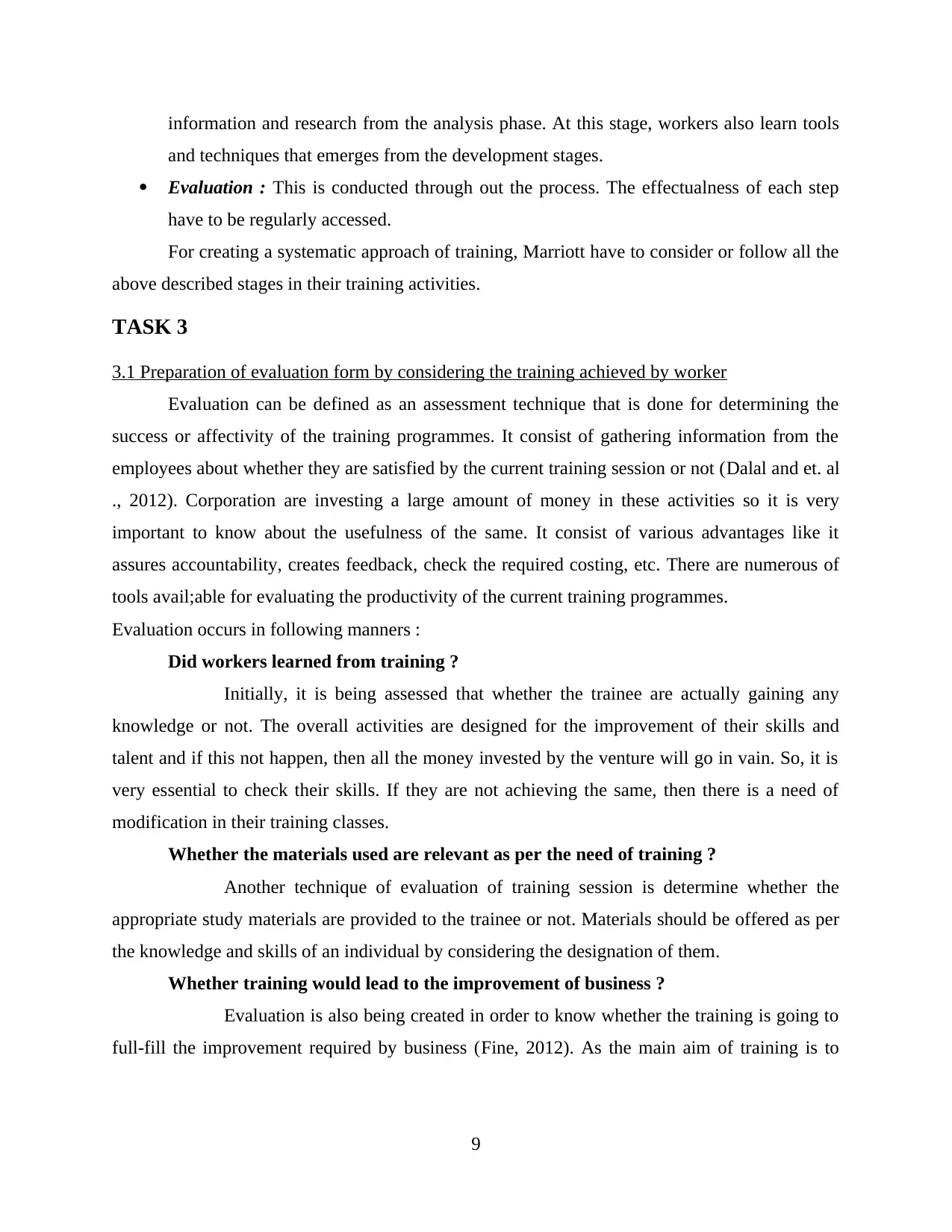
information and research from the analysis phase. At this stage, workers also learn tools
and techniques that emerges from the development stages.
Evaluation : This is conducted through out the process. The effectualness of each step
have to be regularly accessed.
For creating a systematic approach of training, Marriott have to consider or follow all the
above described stages in their training activities.
TASK 3
3.1 Preparation of evaluation form by considering the training achieved by worker
Evaluation can be defined as an assessment technique that is done for determining the
success or affectivity of the training programmes. It consist of gathering information from the
employees about whether they are satisfied by the current training session or not (Dalal and et. al
., 2012). Corporation are investing a large amount of money in these activities so it is very
important to know about the usefulness of the same. It consist of various advantages like it
assures accountability, creates feedback, check the required costing, etc. There are numerous of
tools avail;able for evaluating the productivity of the current training programmes.
Evaluation occurs in following manners :
Did workers learned from training ?
Initially, it is being assessed that whether the trainee are actually gaining any
knowledge or not. The overall activities are designed for the improvement of their skills and
talent and if this not happen, then all the money invested by the venture will go in vain. So, it is
very essential to check their skills. If they are not achieving the same, then there is a need of
modification in their training classes.
Whether the materials used are relevant as per the need of training ?
Another technique of evaluation of training session is determine whether the
appropriate study materials are provided to the trainee or not. Materials should be offered as per
the knowledge and skills of an individual by considering the designation of them.
Whether training would lead to the improvement of business ?
Evaluation is also being created in order to know whether the training is going to
full-fill the improvement required by business (Fine, 2012). As the main aim of training is to
9
and techniques that emerges from the development stages.
Evaluation : This is conducted through out the process. The effectualness of each step
have to be regularly accessed.
For creating a systematic approach of training, Marriott have to consider or follow all the
above described stages in their training activities.
TASK 3
3.1 Preparation of evaluation form by considering the training achieved by worker
Evaluation can be defined as an assessment technique that is done for determining the
success or affectivity of the training programmes. It consist of gathering information from the
employees about whether they are satisfied by the current training session or not (Dalal and et. al
., 2012). Corporation are investing a large amount of money in these activities so it is very
important to know about the usefulness of the same. It consist of various advantages like it
assures accountability, creates feedback, check the required costing, etc. There are numerous of
tools avail;able for evaluating the productivity of the current training programmes.
Evaluation occurs in following manners :
Did workers learned from training ?
Initially, it is being assessed that whether the trainee are actually gaining any
knowledge or not. The overall activities are designed for the improvement of their skills and
talent and if this not happen, then all the money invested by the venture will go in vain. So, it is
very essential to check their skills. If they are not achieving the same, then there is a need of
modification in their training classes.
Whether the materials used are relevant as per the need of training ?
Another technique of evaluation of training session is determine whether the
appropriate study materials are provided to the trainee or not. Materials should be offered as per
the knowledge and skills of an individual by considering the designation of them.
Whether training would lead to the improvement of business ?
Evaluation is also being created in order to know whether the training is going to
full-fill the improvement required by business (Fine, 2012). As the main aim of training is to
9
⊘ This is a preview!⊘
Do you want full access?
Subscribe today to unlock all pages.

Trusted by 1+ million students worldwide
1 out of 18
Related Documents
Your All-in-One AI-Powered Toolkit for Academic Success.
+13062052269
info@desklib.com
Available 24*7 on WhatsApp / Email
![[object Object]](/_next/static/media/star-bottom.7253800d.svg)
Unlock your academic potential
Copyright © 2020–2025 A2Z Services. All Rights Reserved. Developed and managed by ZUCOL.





